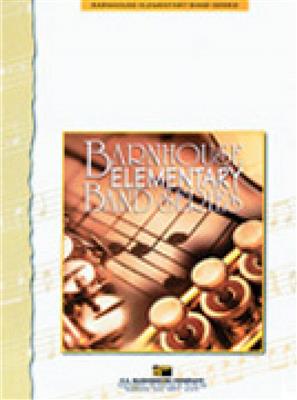Results
-
£64.99
A Haunted Trilogy - J. Johnson
"A Haunted Trilogy" is guaranteed to become a favorite for student and audience alike. Set as a trilogy of three short movements, your band can play one for a quick novelty piece, or all three as a divertimento or program music. "March of the Gremlins" opens the suite with an eerie march. "Tarantella For Trolls" continues the spooky musical fun with a slightly twisted little dance. "Goblin's Gavotte" closes our haunted suite with an ominous romp. It's mischievously impish, looming, conniving, and a great learning piece for chromatics in three different styles. Boo!
Estimated dispatch 7-14 working days
-
£67.99
Adorem - Parker
Jonathan Parker's debut work, "Adorem," is a unique and expressive lyrical composition written for middle and high school bands. Designed to explore a wide range of dynamics and textures, it's an excellent choice for developing blend, balance, phrasing, intonation, and overall musicianship. Sensitively scored, this work is sure to be favorite for performers, conductors, and concert audiences. Highly recommended!
Estimated dispatch 7-14 working days
-
 £49.50
£49.50Proud Spirit - James Swearingen
Commissioned by the Ohio chapter of ASBDA, Swearingen's PROUD SPIRIT is traditional in form, yet contains the writer's "trademark'' contemporary sounds with a fresh approach to scoring. The appealing themes, along with a blockbuster ending, make this march a "must'' acquisition for your library of Swearingen favorites.
Estimated dispatch 7-14 working days
-
 £63.99
£63.99Spirit of the Heartland - Ed Huckeby
A distinctive concert march with a delightfully fresh sound from the pen of popular composer Ed Huckeby. Perfect for contest or concert use, it's full of the compositional trademarks that have made Huckeby's music so popular around the world. Delightful!
Estimated dispatch 7-14 working days
-
£78.99
Battle Of The Winds - Duble
If you've been looking for a march challenge, this is it! "Battle of the Winds" is a classic circus "screamer" that wails from start to finish! Low brass and woodwinds get a workout from top to bottom, and the upper voices squeal in "battle" with the lower voices. Everyone will thrill to the gaudy fun of this vintage circus tune. Not for the faint of heart, and while it's a technical workout, it's well worth the effort. One of the most challenging and exciting marches you'll ever hear!
Estimated dispatch 7-14 working days
-
£63.99
Hot Fudge Sundae - David Martin
Rock n' Roll sound of the 50's & 60's for the very youngest players. A very unique piece at this level and one that will be extremely popular with students and audiences alike. The band set also includes an optional keyboard part which may be used both as a rehearsal aid or as a performance enhancer with smaller groups. VERY NICE AND STILL LOW IN CALORIES!
Estimated dispatch 7-14 working days
-
£49.50
One O'Clock Rock - Ed Huckeby
An inspired novelty arrangement of "Grandfather's Clock" in 50's rock style that is a "must play" at all elementary band concerts. Clever enough to be both interesting and entertaining and easy enough to be accessible to first year players. CAN' BE BEAT!
Estimated dispatch 7-14 working days
-
£60.50
March of the Kangaroos - Ed Huckeby
Huckeby's travels to serve as a band clinician and judge in Australia inspired this infectious novelty piece for your very youngest players. You will not believe the sounds your kids will make at this grade level! It's extremely playable with a more advanced sound, and it really gives the audience that Australian feel. Very Unique.
Estimated dispatch 7-14 working days
-
 £41.99
£41.99Leader of the Class - Ed Hickeby
Here's a piece that attacks the age old problem of how to challenge your best beginning students while not leaving behind the students of lesser abilities. The first Flute/Oboe, Clarinet, Alto Sax and Trumpet parts all contain a variation on the melody which should be performed by your best students. The 2nd parts to those same instruments are written at the regular beginning band level. Contains an optional keyboard part to help out in bands with instrumentation problems. It's a great motivator and will keep your best students challenged. Very Highly Reccommended!
Estimated dispatch 7-14 working days
-
 £41.99
£41.99Kidz' Klassix - Ed Huckeby
An entertaining composition containing bits and pieces of 15 famous childen's tunes that are woven together to create an impressive and appealing audience pleaser. The melodies move around so every section gets a chance to shine and Huckeby's extensive use of cues makes it playable with limited instrumentation! A outstanding piece at this grade level! A REAL WINNER!
Estimated dispatch 7-14 working days
